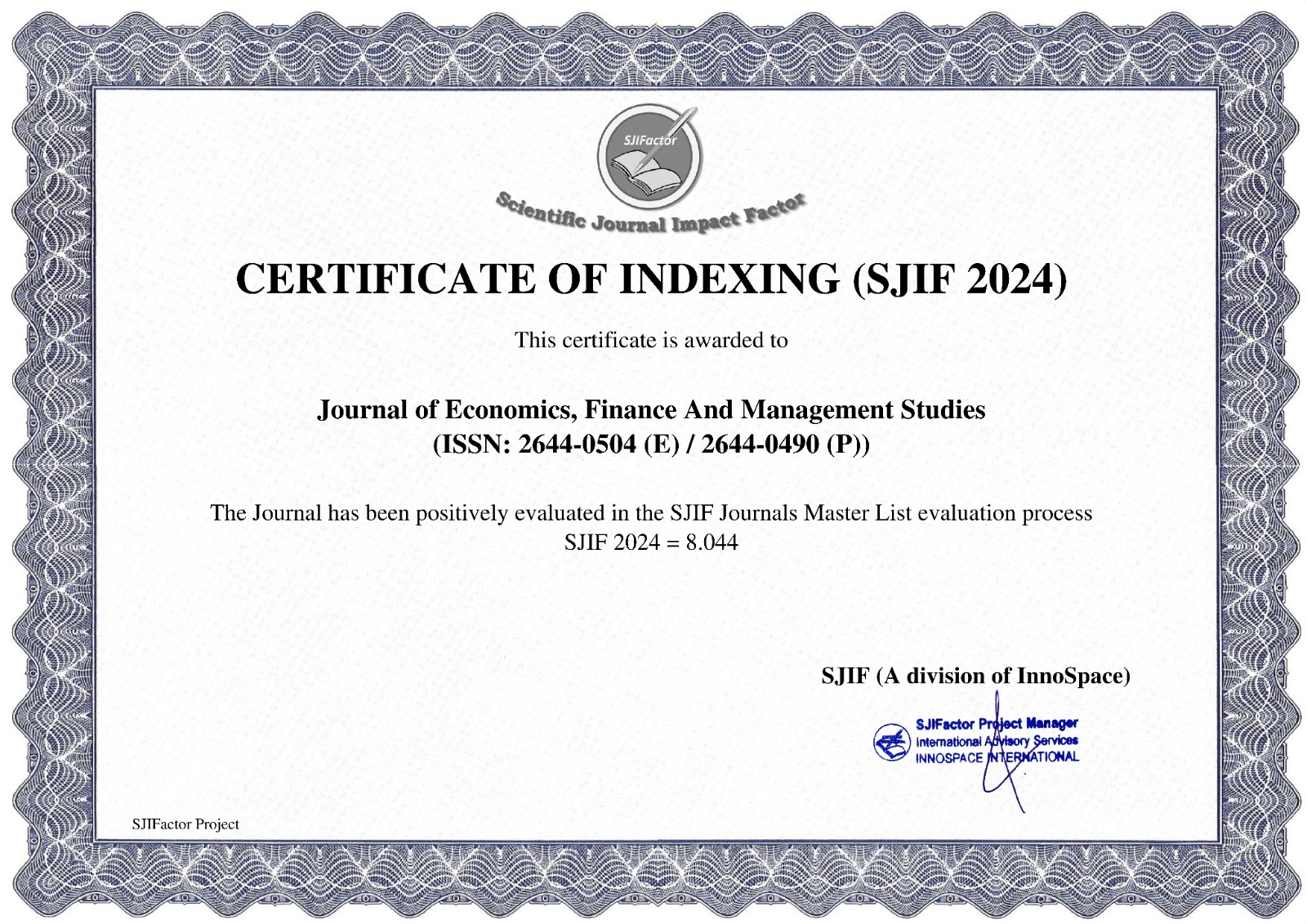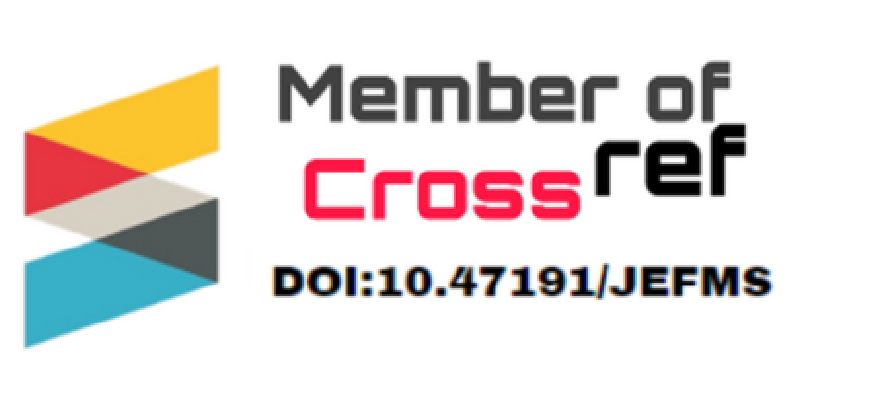e-Naira Implementation and Financial Inclusion in Nigeria: A Review of Literature
1Sadat Ibn Adam, PhD, 2Yakubu Shaba, PhD
1,2Department of Business Administration, Faculty of Management Sciences, Usmanu Danfodiyo University, P. O. Box, 2346, Sokoto, Nigeria
https://doi.org/10.47191/jefms/v8-i3-42ABSTRACT:
The implementation of the e-Naira – Nigeria’s central bank digital currency (CBDC) - represents a transformative shift in the nation’s financial ecosystem. This review explores the impact of the e-Naira on financial inclusion, assessing its potential to bridge the gap between the banked and unbanked adult populations. Drawing on existing literature, this study examines the key motivations behind the e-Naira initiative, including its role in enhancing digital transactions, reducing cash dependency, and promoting economic growth. The review highlights the challenges associated with e-Naira adoption, such as technological barriers, regulatory concerns, and public awareness. Further, it discusses the comparative success of similar digital currencies worldwide and their implications for Nigeria. The findings suggest that while the e-Naira presents significant opportunities for financial inclusion, its success hinges on robust infrastructure, effective policy implementation, and increased public trust. This study contributes to the discourse on digital financial innovation and provides insights for policymakers, financial institutions, and stakeholders in Nigeria’s financial ecosystem.
KEYWORDS:
e-Naira, Implementation, Financial Inclusion, Digital Currency
REFERENCES:
1) Adamu, Y., Aminu, U., & Odu, T. O. (2023). Sentiment Analysis of the Adoption of the e-Naira. Economics of Digital Currencies. A Book of Readings, 213-232.
2) Adegbite, T. A., & Aremu, M. A. (2022). The Effects of Digital Currency (e-Naira) Adoption on Nigeria Economy. Journal of Social Sciences, 8(2), ISSN 2957-4013, е-ISSN 2957-4021.
3) Akpan, U., & Nwanja, T. F. (2022). Central Banks’ Digital Currency and the Challenge of Monetary Policy in Nigeria. Forthcoming.
4) Akpan, U., & Umaru, A. (2024). Can the e-Naira Foster Financial Inclusion in Nigeria? Evidence from Structural Equation Model. Research Square, DOI: https://doi.org/10.21203/rs.3.rs-3861545/v1.
5) Alliance for Financial Inclusion (2017). Integrating Gender and Women’s Financial Inclusion into National Strategies. Guideline Note. No.27.
6) Armas, A., Ruiz, L., & Vásquez, J. L. (2022). Assessing CBDC Potential for Developing Payment Systems and Promoting Financial Inclusion in Peru. BIS Papers Chapters, 123, 131-151.
7) Asidok, N. O., & Michael, A, A. (2018). Mobile Banking Transactions and Bank Profitability in Nigeria. International Journal of Economics, Commerce and Management, 6(6), 692-716.
8) Banet, J, & Lebeau, L. (2022) Central Bank Digital Currency: Financial Inclusion vs. Disintermediation. Federal Reserve Bank of Dallas, Working Paper 2218.
9) Berentsen, A. (2005). Digital Money, Liquidity, and Monetary Policy, First Monday, 89-117.
10) Boar, C., Holden, H., & Wadsworth, A. (2020). Impending arrival–a Sequel to the Survey on Central Bank Digital Currency. BIS paper No. 107.
11) Central Bank of Nigeria, CBN (2012). National Financial Inclusion Strategy.
12) Chukwuere, E. J. (2021). The e-Naira – Opportunities and Challenges. Journal of Emerging Technologies, 1(1); 72-77.
13) Cunha, P. R., Melo, P., & Sebastião, H. (2021). From Bitcoin to Central Bank Digital Currencies: Making sense of the Digital Money Revolution. Future Internet, 13(7), 165.
14) Enhancing Financial Innovation and Access. (2018). EFInA Access to Financial Services in Nigeria 2018 survey. https://efina.org.ng/reports/.
15) Esoimeme, E. (2021). A Critical Analysis of the Effects of the Central Bank of Nigeria’s Digital Currency on Financial Inclusion and AML/CFT Measures. Available at: SSRN 3921396.
16) Eze, G. P., & Egoro, S. (2016). Electronic Banking and Profitability of Commercial Banks in Nigeria. Journal of Finance and Economic Research, 3(1), 202-222.
17) Fabian,O ; Emeka,O., & Chinenye, O. (2022). e-Naira Digital Currency and Financial Performance of Listed Deposit Money Banks in Nigeria, International Journal of Trend in Scientific Research and Development (IJTSRD) 6(2).
18) Fakunmoju, S. K. (2023). Naira Digitalization and Financial Stability of Selected Deposit Money Banks in Nigeria: Are Nigeria Banks Ready?, Economics and Applied Informatics, 2, 83-89.
19) Gopane, T.J. (2019). An Enquiry into Digital Inequality implications for Central Bank Digital Currency. IST-Africa week conference (IST-Africa), 1–9.
20) Grant, M. (2024). Financial Inclusion: Definition, Examples, and Why It's Important. Dotdash Meredith Publishing Family.
21) Gregory, B. (2021). Central Bank Digital Currencies: Costs, Benefits and major Implications for the U.S. Economic System. Bank Policy Institute, Staff Working Paper.
22) Grinberg, R. (2011). Bitcoin: An Innovative Alternative Digital Currency, Hastings Science & Technology Law Journal, 4, 160.
23) Ibrahim, M. L., Adamu, M. M., & Omojashola, A. O. (2022).Can the Central Bank Digital Currency facilitate Financial Inclusion in Maiduguri Metropolis of Borno State? Yantara-Wala Journal of Arts, Management and Social Sciences, 2(2),272-286
24) Igoni, S., Nwadioha, N. A., & Ogiri, I. H. (2022). Evolution of e-Naira for Re-engineering the Nigerian Emerging Economy. Journal of Economics, Finance and Management Studies, 5(10), 2866-2874. https://doi.org/10.47191/jefms/v5-i10-06.
25) Igoni, S., Onwumere, J. U. J., & Amaewhule, P. W. (2020). Digital Currency and Monetary Policy in the South African Economy: Praxis of Financial Dualism and Suggestion for Nigerians. Asian Journal of Economics, Finance and Management, 2(1), 49-57.
26) Inozemtsev, M. I., & Nektov, A. V. (2022). Digital Platforms for Cross-Border Settlement of CBDC in the Platform Economy, Palgrave Macmillan, 131-145.
27) Jabbar, A., Geebren, A., Hussain, Z., Dani, S., & Ul-Durar, S. (2023). Investigating individual privacy within CBDC: A Privacy Calculus Perspective. Research in International Business and Finance, 64, 101826.
28) Jeffery, R. (2014). Reply to George Selgin on Austrian Business Cycle Theory.
29) Kaminska, I. (2021). The e-Naira’s Time Has Come. Financial Times. https://amp.ft.com/content/efa0b41d-d891-4cca-b34e-92d717f15caf
30) Kochergin, D. (2021). Central Banks Digital Currencies, World Experience, 65(5), 68-77.
31) Kochergin, D. A., & Yangirova, A. I. (2019). Central Bank Digital Currencies: Key Characteristics and Directions of Influence on Monetary and Credit and Payment Systems. Finance: Theory and Practice, 23(4), 80-98.
32) Lee, C. C., Li, X., Yu, C. H., & Zhao, J. (2021). Does FinTech Innovation improve Bank Efficiency? Evidence from China’s Banking Industry. International Review of Economics & Finance, 74, 468-483.
33) Li, S., & Huang, Y. (2021). Do Crypto Currencies increase the Systemic Risk of the Global Financial Market? China & World Economy, 28(1), 122-143.
34) Mancini-Griffoli, T., Peria, M. S. M., Agur, I., Ari, A., Kiff, J., Popescu, A., & Rochon, C. (2018). Casting light on Central Bank Digital Currency. IMF Staff Discussion Note, 8(18), 1-39.
35) Morales-Resendiz, R., Ponce, J., Picardo, P., Velasco, A., Chen, B., Sanz, L., Guiborg, G., Segendorff, B., Vasquez, J.L., Arroyo, J., & Aguirre, I. (2021). Implementing a Retail CBDC: Lessons Learned and Key Insights. Latin American Journal of Central Banking 2(1)
36) Murakami, D., Shchapov, I., & Viswanath-Natraj, G. (2022). CBDCs, Financial Inclusion, and Monetary Policy. Available at SSRN 4102397.
37) Neeta, G. (2020, July 31). What are Retail and Wholesale Central Bank Digital Currencies (CBDCs). https://medium.com/akeo-tech/what-are-retail and-wholesale-central-bank-digital-currencies-cbdcs-5c49d81dbbcc.
38) Nwosu, K.C., & Ike-Elechi, O. (2023). Factors Influencing Continuous Intention to Use Mobile Payment Platforms in Southeast. European Journal of Business and Innovation Research, 11(8), 43-75.
39) Obiora, K. I. (2023). Economics of Digital Currencies. A Book of Readings, Central Bank of Nigeria.
40) Oladejo, M. (2016). E-payments adoption and Profitability Performance of Deposits Money Banks in Nigeria. IPASJ International Journal of Information Technology (IIJIT), 4(3), 1-9.
41) Olga, C. G., Enestor, D. S., Santiago, F., Alejandro, N. & Javier, S. (2017). Central Bank Digital Currencies: Assessing Implementation Possibilities and Impacts. BBVA Research Working Paper, 17/04.
42) Oseni, U. A. (2023). Case of Nigeria. Standing Committee for Economic and Commercial Cooperation of the Organization of Islamic Cooperation (COMCEC)
43) Ozili, P. K. (2020). Theories of Financial Inclusion in Uncertainty and Challenges in Contemporary Economic Behaviour. Emerald Publishing Limited.
44) Ozili, P. K. (2022). Central Bank Digital Currency Research around the World; A Review of Literature, Journal of Money Laundering Control, 1368-5201.
45) Ozili, P. K. (2023). Determinants of Interest in e-Naira and Financial Inclusion Information in Nigeria. The Role of FinTech, Crypto currency and Central Bank Digital Currency, Digital Transformation and Society,2(2), 202-214, ISSN: 2755-0761.
46) Ree, J. (2023). Nigeria’s e-Naira, One Year after. IMF Working Paper No. 2023/104, Available at SSRN: https://ssrn.com/abstract=4529341 or http://dx.doi.org/10.5089/9798400242113.001.
47) Wezel, T., & Ree, J .J. (2023) Nigeria—Fostering Financial Inclusion through Digital Financial Services, International Monetary Fund Amazon.com 48) World Bank Open Data (n.d). Free Access to Global Development Data. https://data.worldbank.org/
49) World Bank (2015). The World Bank Annual Report 2015. The World Bank Group
50) World Population Prospect (2022). Department of Economics and Social Affairs, Population Division, United Nations
51) Zuluaga, D. (2021). Which type of Digital Currency for Financial Inclusion? Cato Journal, 41, 413.
















